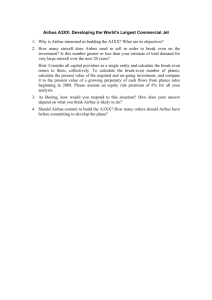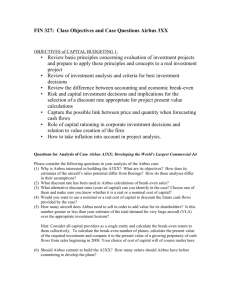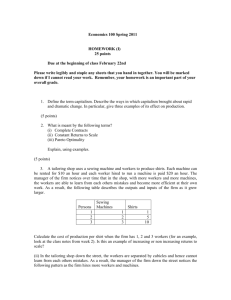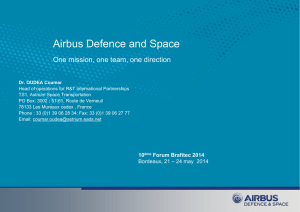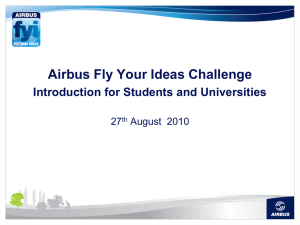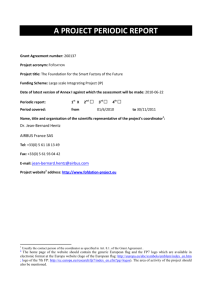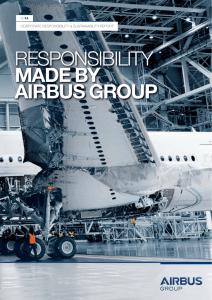schedule of classes - University of Connecticut
advertisement
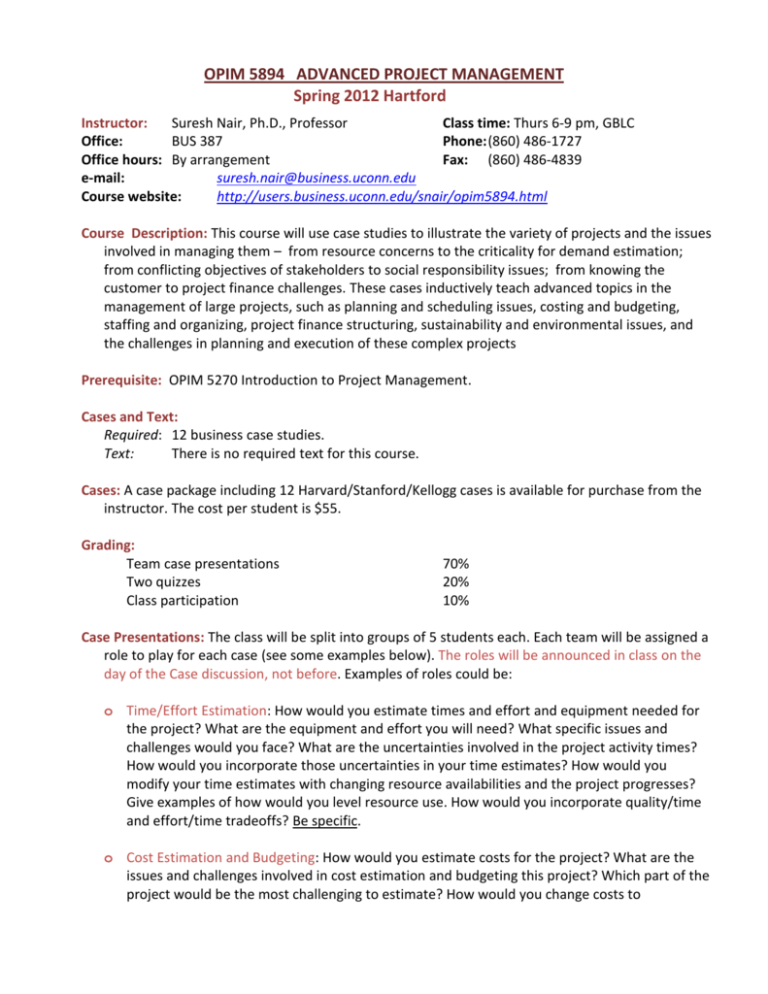
OPIM 5894 ADVANCED PROJECT MANAGEMENT Spring 2012 Hartford Instructor: Suresh Nair, Ph.D., Professor Class time: Thurs 6-9 pm, GBLC Office: BUS 387 Phone: (860) 486-1727 Office hours: By arrangement Fax: (860) 486-4839 e-mail: suresh.nair@business.uconn.edu Course website: http://users.business.uconn.edu/snair/opim5894.html Course Description: This course will use case studies to illustrate the variety of projects and the issues involved in managing them – from resource concerns to the criticality for demand estimation; from conflicting objectives of stakeholders to social responsibility issues; from knowing the customer to project finance challenges. These cases inductively teach advanced topics in the management of large projects, such as planning and scheduling issues, costing and budgeting, staffing and organizing, project finance structuring, sustainability and environmental issues, and the challenges in planning and execution of these complex projects Prerequisite: OPIM 5270 Introduction to Project Management. Cases and Text: Required: 12 business case studies. Text: There is no required text for this course. Cases: A case package including 12 Harvard/Stanford/Kellogg cases is available for purchase from the instructor. The cost per student is $55. Grading: Team case presentations Two quizzes Class participation 70% 20% 10% Case Presentations: The class will be split into groups of 5 students each. Each team will be assigned a role to play for each case (see some examples below). The roles will be announced in class on the day of the Case discussion, not before. Examples of roles could be: o Time/Effort Estimation: How would you estimate times and effort and equipment needed for the project? What are the equipment and effort you will need? What specific issues and challenges would you face? What are the uncertainties involved in the project activity times? How would you incorporate those uncertainties in your time estimates? How would you modify your time estimates with changing resource availabilities and the project progresses? Give examples of how would you level resource use. How would you incorporate quality/time and effort/time tradeoffs? Be specific. o Cost Estimation and Budgeting: How would you estimate costs for the project? What are the issues and challenges involved in cost estimation and budgeting this project? Which part of the project would be the most challenging to estimate? How would you change costs to incorporate delays or required speed-ups? How would you finance this project? How would you incorporate quality/cost and time/cost tradeoffs? Be specific. o Risk assessment and management: What risks are involved in the project? How would you analyze and assess these risks. What risk mitigation strategies would you put in place? What issues and challenges would you face in fulfilling your role? How would you incorporate risk/time and risk/cost tradeoffs? Be specific. o Preplanning, Staffing and Organizing: Do a cost/benefit analysis of the project. How would you staff the project? What kind of organization would you use? What would be the issues and challenges you might face? How would you incorporate staffing/time and staffing/budget tradeoffs? Be specific. o Execution, monitoring and control: How would you plan execution of the project? Give a WBS for the project. What would be the tollgates? How would you liaise with management and/or client? What systems and methods would you use to monitor progress and exercise control on the project. How would you monitor quality during the execution? What actions would you take if the project is behind schedule? Be specific. o Client/End User : The Professor and the rest of the class will play the role of Client/End User Each student should read the case thoroughly before class (there are broad questions of interest mentioned at the end of this document). The initial part of the class would be devoted to the Professor presenting an overview of the case and answering any general questions. The teams will then break out and role-play their assigned function in the case. In the second half of class, each team will make a 10 minute presentation on their strategy, tools and techniques used, issues and challenges in their function for that particular case. Be as specific and detailed as possible, avoiding generalities. The class will ask questions of the team after their presentation. The rest of the class will rate the presentations of each team (other than their own). These presentation decks should be sent to the Professor by e-mail. The in-class presentation and the deck will be graded by the Professor. Quizzes: The two quizzes will consist of multiple choice questions from cases covered. SCHEDULE OF CLASSES Class 1 Date 19-Jan Topic 2 26-Jan California High Speed Rail case Case presentation 3 2-Feb Integrated Project Delivery at Autodesk Case Case presentation 4 9-Feb Airbus A3XX Development Project Case Case presentation 5 16-Feb Corning Early Stage Opportunity Identification Case Case presentation 6 23-Feb Jet Propulsion Laboratory Case Case presentation 7 1-Mar A&D HighTech (A) Case Case presentation 8 8-Mar Poland's A2 Motorway Case Case presentation Quiz 1 9 22-Mar Ariba Implementation at MedX Case Case presentation 10 29-Mar Chad-Cameroon Petroleum Dev and Pipeline Project Case Case presentation 11 5-Apr Vertex Pharma R&D Portfolio Management Case Case presentation 12 12-Apr Iridium LLC Case Case presentation 13 19-Apr Salt Lake Olympics Case Case presentation 14 26-Apr Teaching Evaluation Quiz 2 Introduction to the course HuskyDM Project Suggested Questions for Cases Integrated Project Delivery at Autodesk Case: 1. How would you characterize the US construction industry? Specifically, what can enable or impede change in this industry? 2. What were Autodesk’s objectives for the project? How feasible is this set of multiple goals give the project opportunities and constraints? 3. How was IPD defined for this project? In particular, what do you think about its risk management model, joint management structure, and compensation strategy? 4. Why did Autodesk request use of Building Information Modeling (BIM)? What challenges and opportunities does BIM pose for the project team? 5. Which, if any, of the three atrium options should be chosen? Evaluate the implications of your suggestion for process sequencing, timeline, team dynamics, risk and compensation. 6. What are the strengths and limitations of technology enabled IPD? California High Speed Rail Case: 1. 2. 3. 4. Do you think CASHR is a worthwhile project from the state’s perspective? What are the demand and revenue risks of the project? What are the risks of cost overruns, delays and other implementation problems? Do a cost/benefit analysis of the project. Should the taxpayer subsidize the project? Airbus A3XX Development Project Case: 1. Why is Airbus interested in building the A3XX? What are its objectives? 2. How many aircraft does Airbus need to sell in order to break even on the investment? Is this number greater or less than your estimate of total demand for very large aircraft (VLA) over the next 20 years? Hint: Consider all capital providers as a single entity and calculate the break-even return to them collectively. To calculate the break-even number of places, calculate the present value of the required investment, and compare it to the present value of the growing perpetuity of cash flows from planes sales beginning in 2008. Assume an equity risk premium of 6% in your analysis, if you wish. 3. As Boeing, how would you respond to this situation? How does your answer depend on what you think Airbus is likely to do? 4. Should Airbus commit to build the A3XX? How many orders should Airbus have before committing to develop the plane? Corning Early Stage Opportunity Identification Case: 1. As a result of the telecom meltdown in 2000, what was done differently? How has the philosophy of innovation changed? 2. What is key to the success of EMT? 3. In your opinion, which of the seven questions would be most challenging to answer? 4. What else would the Mercury Abatement team need to strengthen their case? Jet Propulsion Laboratory Case: 1. Should Gentry Lee recommend launch or delay for the MBE mission? What are the most important factors to consider in this decision? 2. Identify the principal risk management processes used in the MBE project. What role does each play, and what is critical for its success? 3. Consider the role of JPL’s senior systems engineer, Gentry Lee. What challenges did he face when implementing the risk management processes at JPL? What characteristics seem critical for his success? 4. Do the new risk management processes match JPL’s strategy and culture? A&D High Tech Case: Professor will provide Excel spreadsheet of Exhibits 5-9 1. What is the projected completion date? (Assume there are no holidays, and ignore the sunk cost of the planning team’s effort). 2. What is the total cost? How much of the total costs are labor costs? Capital costs? 3. What is the critical path(s) in the project? How would you assess the level of risk in the project? 4. What is your opinion on the potential for the project to be completed on time? Poland’s A2 Motorway Case: 1. What are the major risks in this project? Have they been properly identified, assessed, and mitigated under the current structure? 2. Who bears the major risks? What factors determine who should bear the major risks? 3. What are various strategies you can use to manage project risks? For example, when is it appropriate to prevent, hedge, insure, allocate or bear particular risks? 4. How should Gebicki respond to the banker’s concerns? Ariba Med-X Case: Professor will provide Excel spreadsheet of Exhibits 5-8 1. Which of the two components are underperforming according to the plan? How do you know this? 2. Are the components of the project within budget? How do you know? 3. What can you conclude by looking at the combined earned value data for the project? 4. Why did Terry Baker think that the project was going according to plan the entire time? 5. How much longer will the project take? 6. What should Martin have done earlier in the project timeline to prevent delays? 7. What should Martin do when managing future projects to prevent similar problems from developing? Chad Cameroon Case: 1. How are the sponsors financing this deal? How does the financing of the Field System differ from financing of the Export System? 2. What is the World Bank/IFC’s role in this deal? Are they likely to be successful? 3. Analyze the risks and returns to Chad, Cameroon and the Private Sponsors? How were the returns calculated? Are the risks and returns fair from each party’s perspective? 4. Will the Revenue Management Plan work? Are there aspects of the plan that you think should be changed? 5. Would you approve the deal as a World Bank/IFC board member? Vertex Pharma R&D Portfolio Management Case: 1. Which of the project portfolio options currently facing Vertex do you favor? Specifically, which two projects would you advance in development? Would you license out the two others not chosen or keep them as backup? 2. What criteria would you use to make the decision? What other information, if any, do you think Boger needs to make his decision? 3. What approach should be used to make a decision like this? How much should Vertex management rely on quantitative methodologies (such as real option valuation) versus more qualitative approaches? How should the company value investments in projects like these, which entail an extremely high degree of uncertainty? What management process should be used? Iridium LLC Case: 1. What caused Iridium to fail: was it a bad strategy, bad execution, or bad luck? 2. Why did Motorola finance Iridium with project debt rather than corporate debt? 3. What lessons regarding large, greenfield projects do you draw from this case? Salt Lake Olympics Case: 1. TBA
